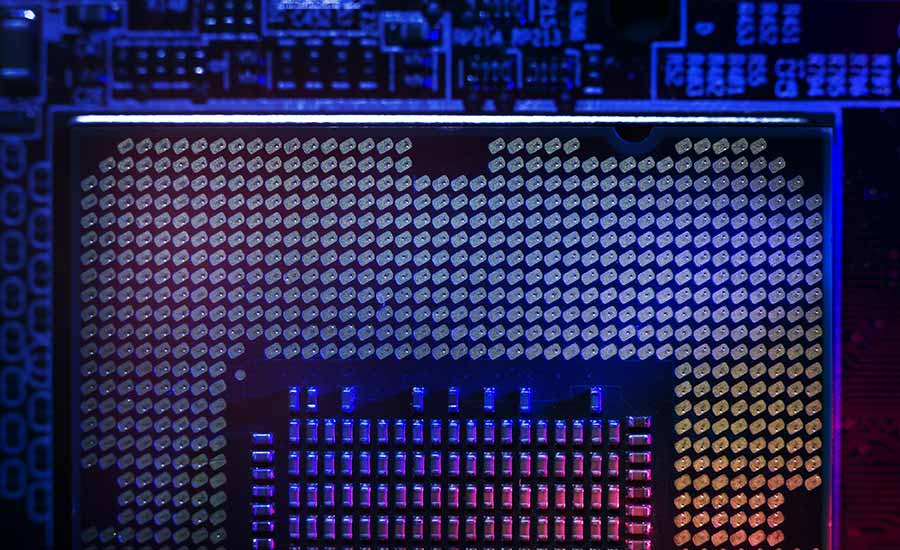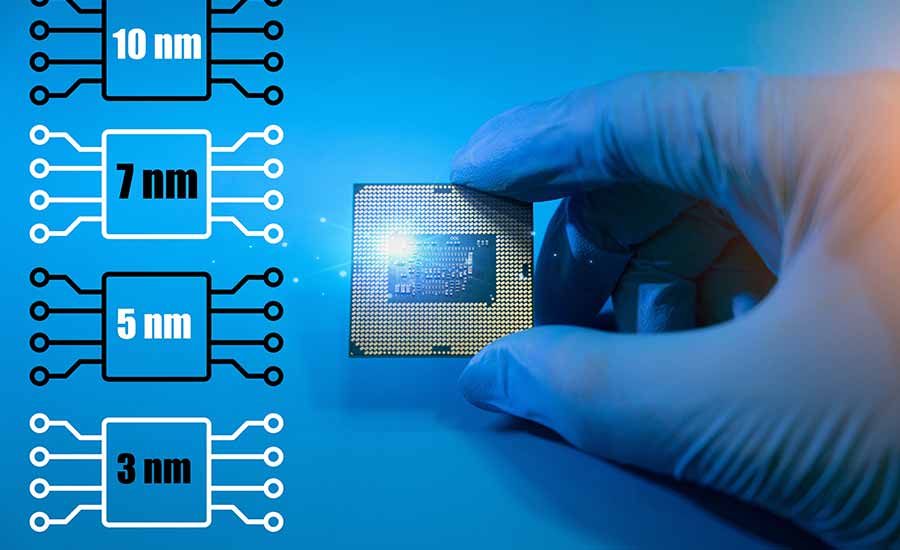
The semiconductor industry is in a technological revolution, racing towards the development of 1 nanometer chips. These minuscule yet powerful components are set to redefine the limits of computing.
Central to this endeavor is Moore’s Law, the guiding principle that has driven exponential growth in computing power for over five decades.
We’ll explore the intricacies of nanometer chip technology, the role of Moore’s Law, and the key players vying for supremacy in this high-stakes race. We’ll delve into the technological challenges and groundbreaking innovations and assess the impact on various industries and applications
Introduction to Nanometer Chips
The importance of nanometer chips lies in their ability to drive the performance of electronic devices. As technology demands increase, from smartphones to data centers, smaller and more powerful chips enable more sophisticated applications, improved energy efficiency, and better overall performance.
This miniaturization is essential for the development of next-generation technologies such as artificial intelligence, autonomous vehicles, and advanced medical devices.
How Moore’s Law Has Guided Chip Development
For decades, Moore’s Law has served as a roadmap for the semiconductor industry, driving companies to continually innovate and push the boundaries of what is possible.
This relentless pursuit of smaller, faster, and cheaper transistors has led to the development of increasingly powerful and efficient processors, enabling everything from personal computers to smartphones and complex data centers.
The doubling of transistor density has facilitated remarkable improvements in:
- Performance: More transistors allow for more powerful processing capabilities.
- Energy efficiency: Smaller transistors require less power, reducing heat output and energy consumption.
- Cost: Increased transistor density reduces the cost per transistor, making advanced technology more affordable.
Major Players in the Nanometer Chip Race
The race towards 1 nanometer chips is a high-stakes competition involving some of the most prominent technology companies in the world. In this section, we will provide an overview of the major players, their recent advancements, and the different strategies they employ to lead in the nanometer chip race.
TSMC (Taiwan Semiconductor Manufacturing Company)
TSMC is the world’s largest dedicated independent semiconductor foundry and a critical player in the chip manufacturing industry. Known for its advanced process technology, TSMC has been at the forefront of producing smaller and more efficient chips.
Recent milestones include:
- 7nm and 5nm Nodes: TSMC has successfully mass-produced chips at these nodes, powering devices from leading tech companies.
- 3nm Development: TSMC is actively developing its 3nm process, with plans for commercial production soon.
- Research on 1nm: The company is investing heavily in research and development to achieve 1nm chip production, leveraging innovations in materials and manufacturing techniques.

Intel
Intel, a pioneer in semiconductor manufacturing, has faced challenges in recent years but remains a key contender in the nanometer chip race.
Intel’s strategies include:
- 10nm and 7nm Processes: After initial delays, Intel is now producing chips at these nodes, with improvements in performance and efficiency.
- Innovative Technologies: Intel is exploring new technologies such as Foveros 3D packaging and RibbonFET transistor architecture to enhance chip performance.
- Path to 1nm: Intel has laid out an ambitious roadmap to reach 1nm, focusing on advanced lithography, materials, and transistor designs.
Samsung
Samsung is another major player, leveraging its expertise in both memory and logic chips.
The company’s achievements and plans include:
- 5nm and 3nm Nodes: Samsung has made significant progress in these nodes, with 3nm chips expected to enter production shortly.
- Gate-All-Around (GAA) Technology: Samsung is developing GAA transistor technology to overcome the limitations of traditional FinFET transistors, crucial for achieving smaller nodes.
- 1nm Vision: Samsung’s research into new materials and innovative manufacturing techniques aims to position it as a leader in the 1nm chip race.
Comparative Analysis of Technologies and Approaches
Each company has its unique approach to achieving 1 nanometer chips:
- TSMC: Focuses on continuous process improvement and collaboration with leading tech companies.
- Intel: Invests in breakthrough technologies and new chip architectures.
- Samsung: Combines expertise in different semiconductor domains and pioneers new transistor technologies.
Collaborations and Ecosystem Development
Collaborations among companies, research institutions, and equipment manufacturers play a crucial role in advancing towards 1nm chips. Initiatives such as the semiconductor industry’s partnerships with ASML for EUV lithography technology exemplify this collaborative effort.
Technological Challenges and Innovations
Achieving the milestone of 1 nanometer chips is faced with significant technological challenges. Overcoming these hurdles requires groundbreaking innovations in materials, manufacturing processes, and design techniques.
Key Technological Hurdles
- Heat dissipation: As transistors shrink, they generate more heat per unit area. Efficient heat dissipation becomes critical to maintaining chip performance and reliability. Traditional cooling methods are insufficient for nanometer-scale chips, necessitating advanced thermal management solutions.
- Quantum effects: At nanometer scales, quantum mechanical phenomena such as electron tunneling, and interference can disrupt transistor operation. These effects can lead to increased power leakage and reduced control over transistor behavior.
- Manufacturing precision: Producing features at the 1 nanometer scale requires unprecedented precision in manufacturing. Even the smallest deviations can lead to significant defects. Current lithography techniques face limitations in achieving the necessary resolution for such small features.
- Material limitations: Silicon, the traditional material for semiconductors, faces limitations at nanometer scales. Researchers are exploring alternative materials that can offer better performance and reliability.
Innovative Solutions and Breakthroughs
- Extreme ultraviolet (EUV) lithography: EUV lithography is a critical innovation enabling the production of smaller features on chips. It uses extremely short wavelengths of light to achieve higher resolution than traditional lithography. Companies like ASML are leading the development of EUV tools, which are now being used in advanced chip manufacturing processes.
- New materials: Researchers are investigating materials such as graphene, carbon nanotubes, and transition metal dichalcogenides (TMDs) for their superior electrical properties at nanometer scales. These materials promise to overcome some of the limitations of silicon, enabling faster and more efficient transistors.
- Advanced transistor architectures: Innovations such as Gate-All-Around (GAA) transistors and FinFETs (Fin Field-Effect Transistors) offer better control over electron flow, reducing power leakage and improving performance. GAA transistors, in particular, are seen as a key technology for achieving sub-3nm nodes.
- 3D integration and packaging: 3D integration involves stacking multiple layers of transistors vertically, increasing the density and performance of chips without shrinking individual transistors. Techniques like Foveros and chiplet-based designs enable modular chip construction, enhancing flexibility and performance.
- AI and machine learning in chip design: AI and machine learning are being used to optimize chip design and manufacturing processes. These technologies can predict and mitigate defects, improve design efficiency, and enhance performance.

Impact on Industries and Applications
The advent of 1 nanometer chips promises to revolutionize multiple industries, driving innovations and transforming applications across various fields.
Some of the industries that nanometer chips will impact include:
1. Artificial Intelligence (AI) and Machine Learning
1 nanometer chips will significantly enhance the computational power available for AI and machine learning applications, enabling more complex models and faster processing times.
These advancements will lead to more sophisticated AI capabilities, including better natural language processing, image recognition, and autonomous systems.
2. Internet of Things (IoT)
The IoT ecosystem will benefit from the energy efficiency and compact size of 1 nanometer chips, allowing for more powerful and longer-lasting sensors and devices.
This will enable smarter homes, cities, and industrial systems, with improved data collection, processing, and real-time analytics.
3. Healthcare and Biotechnology
In healthcare, 1 nanometer chips will power advanced medical devices, including wearable health monitors, diagnostic equipment, and personalized medicine applications.
These chips will facilitate real-time health monitoring and more accurate diagnostic tools, improving patient outcomes and reducing healthcare costs.
4. Consumer Electronics
Smartphones, laptops, and other consumer electronics will become more powerful and efficient, with enhanced performance and longer battery life.
Users will experience smoother multitasking, improved graphics, and faster connectivity, enhancing overall device usability and satisfaction.
5. Automotive Industry
The automotive sector will see significant advancements in autonomous driving technology, vehicle-to-everything (V2X) communication, and in-car entertainment systems.
1 nanometer chips will provide the processing power needed for real-time data analysis and decision-making, crucial for the safe operation of self-driving cars.
Expected Performance Improvements and Their Implications
- Increased processing speed: 1 nanometer chips will offer unprecedented processing speeds, enabling faster execution of complex tasks and more responsive applications.
- Enhanced energy efficiency: The reduction in power consumption will be critical for battery-powered devices, extending battery life and reducing the environmental impact of electronic devices.
- Greater integration density: Higher transistor density will allow for more functionality to be integrated into a single chip, reducing the size and cost of electronic devices.
Future Prospects and Predictions
As the semiconductor industry reaches towards 1 nanometer chips, the future holds exciting advancements in sub-nanometer technologies and also many more future prospects and predictions.
These prospects and predictions include:
1. Sub-Nanometer Technology
Researchers are already exploring possibilities beyond 1 nanometer, including sub-nanometer and even picometer-scale technologies.
Innovations in quantum computing and nanoscale fabrication techniques will be essential for these advancements.
2. New Computing Paradigms
Beyond traditional silicon-based chips, alternative computing paradigms such as quantum computing, neuromorphic computing, and optical computing are gaining traction.
These paradigms promise to revolutionize computing by offering fundamentally different approaches to processing and data storage.
3. Advanced Materials and Manufacturing Techniques
Continued exploration of advanced materials like 2D materials (e.g., transition metal dichalcogenides) and topological insulators will open new frontiers in chip design.
Novel manufacturing techniques such as molecular beam epitaxy and atomic layer deposition will enable more precise and efficient fabrication of nanoscale devices.
4. Sustaining Moore’s Law
While the traditional interpretation of Moore’s Law may face limits, experts believe its underlying principle of exponential growth in computing power will continue through new innovations.
Industry leaders suggest that heterogeneous integration, combining different types of processors and specialized accelerators, will extend the spirit of Moore’s Law.
5. Economic and Environmental Impact
The economic impact of achieving 1 nanometer chips will be profound, driving growth in technology sectors and creating new markets.
Environmentally, the focus will be on developing energy-efficient chips that reduce the carbon footprint of data centers and electronic devices.
Learn About the Latest Semiconductor Trends with AGS Devices
At AGS Devices, we specialize in distributing top-quality semiconductors, adhering to the highest standards of quality control. Our commitment to excellence begins with a thorough initial inspection and rigorous testing to confirm both the authenticity and performance of our products.
This meticulous process ensures that the semiconductors we supply meet the diverse high-performance requirements of various applications.
In addition to semiconductors, we offer a wide range of electronic components, including:
- Power Supply Distributors
- Optoelectronics
- Circuit Protection
- Interconnects
- Passive Components Electronics
- Electronic Testing Equipment
- Electromechanical Devices
Staying at the forefront of semiconductor trends, we keep a keen eye on advancements like the development of 1 nanometer chips and the ongoing influence of Moore’s Law.
These trends are revolutionizing the industry, driving innovations that enhance performance and efficiency across a myriad of applications.
Our dedication to integrating the latest advancements ensures that our products not only meet but exceed industry standards, preparing you for the future of technology.
